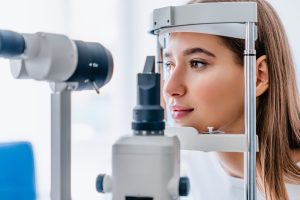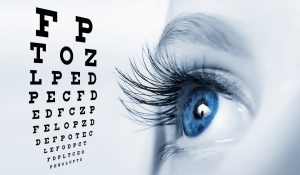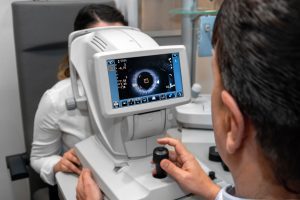Cataracts
Cataracts are a condition where the eye’s natural lens becomes cloudy, resulting in blurred vision and other sight-related issues. Most cases of cataracts are related to oxidation of the natural crystalline lens located inside the eye due to aging, as well as UV exposure over time. There are some cataracts that are congenital (you are born with them) or acquired through damage or injury to the eye. There are also rare types of cataracts that are acquired from some specific health conditions or medications or come about earlier on in life than the typical age-related types. Cataracts can occur in one or both eyes at different rates. Most people over the age of 45 have them starting, but they typically don’t become visually significant until into the 60’s, 70’s, or 80’s. They most commonly are very slow to change over the years, but in the later stages can change rapidly within a few months or even weeks. Some health conditions, such as uncontrolled diabetes with large changes in blood sugar, can accelerate the rate of change in a cataract.
Symptoms may include:
- Blurred vision – can be rapid or slow onset
- Halos around lights
- Difficulty seeing at night
- Sensitivity to light
- Ghosting or double images – specifically out of one eye at a time
With early diagnosis and treatment, cataracts can be managed effectively. The proper treatment is the removal of the natural lens in the eye and replacement with a plastic lens that can be set to your prescription. Most people experience a large reduction in their prescription with cataract surgery. There are specific lens upgrades in the replacement lens to correct for astigmatism or even reduce the reliance on reading glasses after surgery. Sometimes natural lens replacement before you have cataracts can be recommended as a form of vision correction surgery as well! This is typically reserved for people with a large prescription that is outside the typical range of typical vision correction surgery like LASIK or PRK, as it is quite expensive. If you think you may have cataracts or are interested in more information about Refractive Lens Exchange, it is important to see your eye doctor for an evaluation. Contact us at Louie Eyecare Centre to book your next eye exam and get checked for cataracts.
West Edmonton Vision Clinic
Visit our vision clinic in central West Edmonton for comprehensive eye exams, contact lens fittings, glasses, and more. Louie Eyecare Centre is dedicated to providing the highest quality optometric services and products to our patients. Our team of experienced optometrists is here to help you with all of your eye care needs. Schedule an appointment today!
Clinic Hours
Monday Closed
Tuesday 9:00-5:00
Wednesday 9:00-5:00
Thursday 9:00-5:00
Friday 9:00-5:00
Saturday 9:00-2:00
Closed Sunday / Holidays
OUR CLIENTS' FEEDBACK
Frequently Asked Questions
Wearing glasses or contacts can indeed affect dry eye symptoms, but the impact varies. Glasses can help shield the eyes from environmental factors that exacerbate dry eye, such as wind or air conditioning. On the other hand, contact lenses can sometimes worsen dry eye symptoms by absorbing tear moisture or by causing irritation. Certain types of contact lenses are designed to be more breathable and retain moisture better, which may be suitable for people with dry eyes. It’s crucial to discuss with an eye care professional to find the most appropriate type of contact lens or glasses. Proper care and hygiene when using contacts, along with regular breaks from screen use, can help minimize dry eye symptoms.
Dry eye syndrome can be both a temporary condition and a chronic disease, depending on its cause and severity. Environmental factors or certain life situations, such as screen use or air travel can cause temporary dry eye. Chronic dry eye, on the other hand, may result from systemic diseases, medication side effects, or age-related changes in tear production. Management and treatment can alleviate symptoms, but chronic dry eye often requires ongoing therapy. It’s important to consult with an eye care professional for an accurate diagnosis and treatment plan. Understanding the underlying cause is key to determining whether dry eye syndrome will be a temporary issue or a chronic condition.
Yes, some specific exercises and therapies can help relieve dry eye symptoms. Blinking exercises, for example, can help improve meibomian gland function and tear film stability. Warm compresses applied to the eyes can also stimulate tear production and release oils from the glands in the eyelids. Gentle eyelid massages can help spread the oils evenly across the eye surface, reducing dryness. Using a humidifier to add moisture to the air and taking regular breaks to rest the eyes during screen time can also be beneficial. Newer technologies such as IPL (Intense Pulsed Light) and RF (Radio Frequency) are also becoming available. Consulting with an eye care professional for personalized advice on exercises and therapies is recommended.
Sleep plays a crucial role in managing dry eye syndrome. Poor sleep can lead to insufficient eye lubrication and worsening dry eye symptoms. During sleep, the eyes rejuvenate and produce the moisture needed for the next day. Good sleep hygiene practices can help ensure the eyes are well-rested and hydrated. It’s also important to avoid sleeping with any airflow directly hitting the face, as this can dry out the eyes. Establishing a regular, restful sleep schedule can significantly improve dry eye symptoms.
Indeed, some medications can exacerbate dry eye symptoms. Diuretics, antihistamines, antidepressants, and some blood pressure medications are known to reduce tear production or alter tear composition. It’s important to review any current medications with a healthcare provider to determine if they could be contributing to dry eye symptoms. Sometimes, alternative medications with fewer dry eye side effects can be prescribed. Always consult with a healthcare professional before making changes to medication regimens. Patients should also stay hydrated and consider using artificial tears if taking medications known to cause dryness.
Yes, it is quite common for dry eye symptoms to worsen in certain weather conditions. Dry, windy, or smoky environments can lead to increased tear evaporation, exacerbating symptoms. Conversely, high humidity can sometimes alleviate dry eye symptoms because the air is more saturated with moisture. Cold weather, especially during winter when indoor heaters are used, can also dry out the eyes. It’s advisable to use humidifiers in such conditions to maintain indoor humidity levels. Wearing wraparound glasses or protective eyewear outdoors can help shield eyes from harsh conditions.




